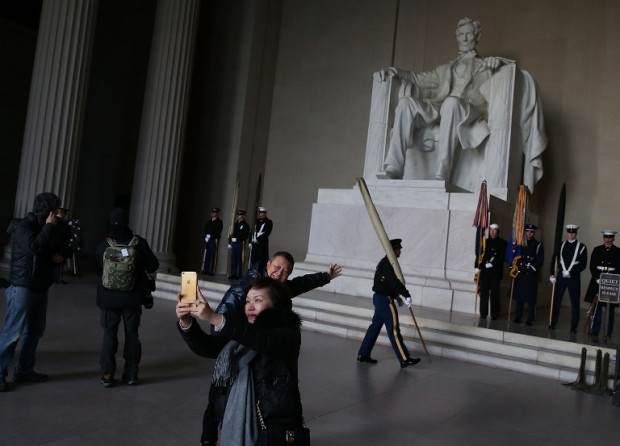
This file photo taken on February 11, 2016 shows tourists taking a picture before a wreath laying ceremony at the Lincoln Memorial, February 12, 2016 in Washington, DC. Donald Trump and his travel bans are dissuading some foreigners from vacationing in the United States, but a decline in visitors is also linked to the dollar and may be limited, experts say.
/ AFP PHOTO / GETTY IMAGES NORTH AMERICA / MARK WILSON
Donald Trump and his travel bans are dissuading some foreigners from vacationing in the United States, but a decline in visitors is also linked to the dollar and may be limited, experts say.
Although solid data is not yet available, the Republican president’s first travel ban sent a jolt through the world tourism industry when it came into effect in late January.
Besides travelers from the seven Muslim-majority countries initially targeted, anecdotal shows evidence of a knock-on effect further afield.
The online tour operator Kayak saw a 23 percent decline in flight searches from Europe to the United States the day after the ban was enacted.
And worldwide bookings to the country of the Statue of Liberty, Hollywood and Disney World fell 6.5 percent in the week after the restrictions took effect, industry analysts ForwardKeys found.
Twenty-nine percent of Britons — who make up the largest number of foreign visitors to the United States after Canadians and Mexicans — said in mid-February that they were less likely to visit the country now Trump is in power, a Cheapflights survey reported.
Still, even though the US president signed a revised travel ban on Monday to take effect on March 16 — with the White House hoping this one avoids the legal challenges that blocked the first attempt — the picture is not all bleak.
If British holiday bookings to the United States for the summer are down year on year, a spokesman for the British Travel Agents Association (ABTA) said, that’s “always the case when sterling falls in value against the dollar.”
That’s been the case since shortly after Trump’s election in November, when his plans to slash regulations along with corporate taxes boosted the dollar.
“It may be that the election of Donald Trump has changed the travel plans of some customers, but it needs to be remembered that he has supporters as well as detractors in the UK,” the spokesman said.
Bookings from Germany also dropped when the euro-dollar exchange rate fell in 2016 with Barack Obama still in power, a spokesman for the German Travel Association (DRV) said.
But the exchange rate doesn’t explain everything, according to the CEO of the French travel association Voyageurs du Monde, Jean-Francois Rial.
“We prefer to go to Mexico or Canada because of Trump,” he said. “We still have people every week who tell us that.”
New York braces for fewer visitors
Ironically, Mexico — so often in Trump’s firing line — may benefit from the US president’s poor image: Cheapflights has also seen a rise in Mexico-related searches.
The first ban had “a broad chilling effect” on international travel demand to the United States, the US Travel Association said.
It expressed regret that the Trump administration did not take advantage of its revised ban to assure those not affected that they are welcome in the United States.
“If undecided voters need to hear certain things to be motivated to get out and vote, then the same is true for undecided travelers,” it said.
NYC & Company, the official marking organization for New York, expects 300,000 fewer international visitors in 2017 “in light of the recent travel ban and related rhetoric,” it said.
If confirmed, it would be the first decline since 2008, the start of the global financial crisis.
That’s especially significant for the economy because if foreign tourists number fewer than American visitors to New York — 12.4 million compared to 49.3 million expected this year — they spend an average of four times more per visit, the organization says.
Still, the market research company Euromonitor predicts only a mild slowdown that would deprive the United States of several hundred thousand visitors a year and up to one million fewer in 2020, the year of the next presidential election.
In France, Travel & Co director Carole Ange says she is not expecting a catastrophic year for US visits, just a flat one with no growth in 2016.
“We should have a good late fall once Mr. Trump calms down a bit,” she said.
And north of the US border, the administrator of the Montreal-based travel agent Beltour, Hamza Belhajali, even sees reasons to celebrate a “Trump effect.”
There’s increasing demand for trips to New York and Washington, he said, among those “curious to go and see what’s happening” in Trump’s America.